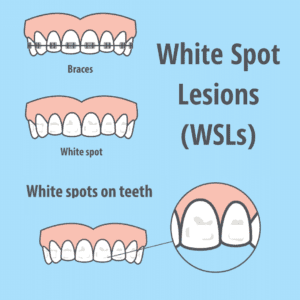Treating White Spot Lesions


After undergoing a year or more of orthodontic treatment, most people cannot wait to get their braces off to see the final results. At first glance, most people are likely thrilled with their braceless teeth that are now perfectly aligned. Upon closer inspection, however, some people may notice tiny white spots on the surface of their teeth that don’t come off no matter how hard they brush.
White-spot lesions (WSLs) are demineralized spots of enamel that have a milky white appearance. Although they can form on anyone’s teeth, individuals who are undergoing orthodontic treatment have been found to be at an increased risk for developing white spot lesions. According to a study cited in an article published by the Journal of the American Dental Association, about 50% of orthodontic patients have one or more WSL, as compared to only 11% of those not receiving orthodontic treatment.
People undergoing orthodontic treatment are at an increased risk for WSLs due to the amount of plaque that accumulates along the boundaries of fixed orthodontic appliances. The excess dental plaque means there is higher concentration of acid in this area. The acid makes it so that the enamel is unable to remineralize itself, resulting in the formation of WSL. In some cases, WSLs can eventually develop into dental cavities.
How to Prevent White Spot Lesions?
Because the best way to treat white spot lesions is to prevent them from occurring altogether, here are some ways to prevent the development of WSLs:
Good Oral Hygiene

This is one of the best ways to prevent white spot lesions from occurring, especially considering that WSLs are caused by excess plaque accumulation. Brushing your teeth twice a day for two minutes with a fluoridated toothpaste is the recommended method for preventing white spots because it removes excess plaque while using fluoride to help mineralize the enamel. Fluoridated mouth rinses can also be used daily, although they are not as effective, since they do not remove plaque in the same way that brushing does.
Listen to Your Orthodontist
Your orthodontist knows how to get the best treatment outcomes and they will pass this information onto you when starting orthodontic treatment. A lack of patient compliance is another common cause of white spots, therefore following the directions provided by your orthodontist can prove to be beneficial and decrease your chances of developing WSLs.
Minimize Sugar Intake
The bacteria in dental plaque that contributes to demineralization use sugar as their main food source. Therefore you increase the amount of plaque and bacteria in your mouth by consuming large amounts of sugar. Conversely, by minimizing the amount of sugar you consume, you can potentially minimize the amount of plaque and reduce the risk of WSLs.
Treating White Spot Lesions
If the preventative measures didn’t work or if you were not aware of these measures while you were undergoing orthodontic treatment, then you may find WSLs on your teeth once your fixed appliance is removed. At this point, the focus switches from prevention to treatment. The treatment of WSLs is still being researched, however some possibilities include applying low concentrations of fluoride, increasing salivary flow, and acid microabrasion.
Fluoride
Fluoride can be topically applied to the teeth with white spots in order to promote remineralization. However, a low concentration of fluoride must be used because concentrations that are too high can permanently halt the remineralization process and result in permanent staining.
Saliva
Saliva is one of the mouth’s natural defense mechanisms. Since fixed appliances can reduce the amount of saliva to particular areas, increasing salivary flow once they are removed can help the pH stabilize so the enamel can remineralize.
Acid Microabrasion
Microabrasion is a technique that is used to eliminate enamel stains by removing the layers that have been stained. Depending on the extent of demineralization, this technique may work to remove the WSL stain, however it will permanently alter the tooth enamel.
Overall, white spot lesions are a potential complication of orthodontic treatment that can be mostly avoided by simply maintaining good oral hygiene habits. Twice daily brushing with fluoridated toothpaste and the possibility of a fluoridated mouthwash will keep your enamel in good shape and prevent the accumulation of excess plaque along the boundaries of a fixed appliance. However, in cases where white spots have occurred, they may be able to be successfully treated with fluoride, saliva, or acid microabrasion.

Dr. Massih attended UCLA, where she graduated Magna Cum Laude with a degree in psychobiology. She then went on to earn her DDS degree at UCLA’s School of Dentistry, where she was awarded the Dean’s Scholarship, and was in the top 10% of her class. She has received her certificate in Orthodontics and Dentofacial Orthopedics at the University of Pittsburgh and is a member of the American Association of Orthodontists, Pacific Coast Society of Orthodontists, & American Dental Association.

Recent Comments